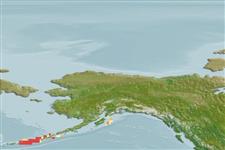Classification / Names
Κοινά ονόματα | Συνώνυμα | Catalog of Fishes(Γένος, Είδη) | ITIS | CoL | WoRMS | Cloffa
>
Perciformes/Zoarcoidei (Eelpouts and pricklebacks) >
Zoarcidae (Eelpouts) > Lycodinae
Etymology: Lycodes: Greek, lykos = wolf + Greek, suffix, oides = similar to (Ref. 45335); akuugun: Named after the Aleut name for the native inhabitants of the Islands of Four Mountains, the region where the species was discovered; noun in apposition.
Environment: milieu / climate zone / depth range / distribution range
Οικολογία
Θαλασσινό(ά) βενθικό(ς); εύρος βάθους 121 - 460 m (Ref. 56970). Temperate
Northeast Pacific: Aleutian Islands.
Μέγεθος / Βάρος / Age
Maturity: Lm ? range ? - ? cm
Max length : 32.4 cm SL αρσενικό/απροσδιόριστο; (Ref. 56970)
Short description
Κλείδες προσδιορισμού | Μορφολογία | Μορφομετρία
Μαλακές ραχιαίες ακτίνες (συνολικά) : 107 - 120; Μαλακές εδρικές ακτίνες: 97 - 103; Σπόνδυλοι: 113 - 120. Diagnosis: Distinguished from the majority of its congeners (46 of 61 currently recognized species) by the ventral position of the lateral line. Among species of Lycodes with a ventral lateral line, the new species is distinguished from brevipes, diapterus, hubbsi, microporus, nakamurae, nishimurai, and ocellatus by the absence of scales on the nape. It is distinguished from all remaining congeners except pectoralis and vahlii by its comparatively high vertebral count (113-120 vs. 94-113 in brunneofasciatus, caudimaculatus, frigidus, gracilis, and obscurus). It is distinguished from pectoralis and vahlii by the presence of an interorbital pore, number of anal-fin pterygiophores preceding the first haemal spine (5-7 vs. 2-4), and the color pattern (pectoralis and vahlii lack light bands on the dorsal fin, light blotches on the upper body, and the bicolor appearance of the head, body, and pectoral fin) (Ref. 56970).
The species were collected in hauls dominated by Atheresthes stomias, Theragra chalcogramma, Hippoglossus stenolepis, and Sebastes alutus; also with Lycodes diapterus and L. concolor. Bottom temperatures of collection sites ranged from 3.3-4.3 °C. Stomach contents of 2 specimens has partially digested sea urchin tests (Ref. 56970).
Life cycle and mating behavior
Γεννητική Ωρίμανση | Αναπαραγωγή | Γεννοβολία | Αβγά | Γονιμότητα | Προνύμφες
Stevenson, D.E. and J.W. Orr, 2006. A new species of Lycodes (Perciformes: Zoarcidae) from the Aleutian Islands. Copeia 2006(1):77-82. (Ref. 56970)
IUCN Red List Status (Ref. 130435: Version 2024-2)
Threat to humans
Harmless
Human uses
Εργαλεία
Special reports
Download XML
Διαδικτυακές πηγές
Estimates based on models
Preferred temperature (Ref.
123201): 3.7 - 4.5, mean 3.9 °C (based on 6 cells).
Phylogenetic diversity index (Ref.
82804): PD
50 = 0.5000 [Uniqueness, from 0.5 = low to 2.0 = high].
Bayesian length-weight: a=0.00120 (0.00058 - 0.00248), b=3.10 (2.91 - 3.29), in cm total length, based on LWR estimates for this (Sub)family-body shape (Ref.
93245).
Τροφικό Επίπεδο (Ref.
69278): 3.4 ±0.5 se; based on size and trophs of closest relatives
Ελαστικότητα (Ref.
120179): Χαμηλό, ελάχιστος χρόνος για διπλασιασμό πληθυσμού 4,5 - 14 έτη (Preliminary K or Fecundity.).
Fishing Vulnerability (Ref.
59153): Low to moderate vulnerability (30 of 100).
